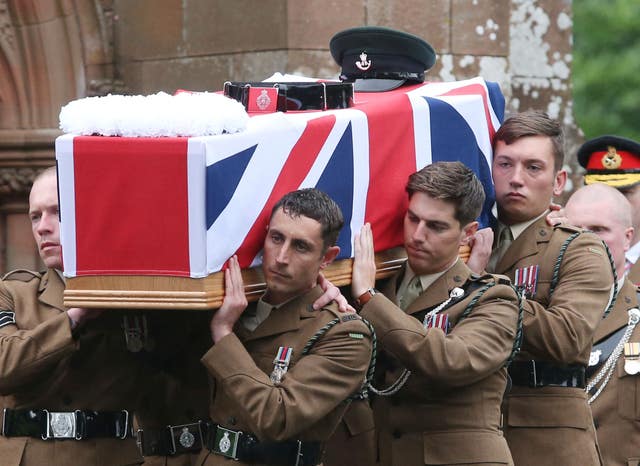
An inquest into the death of a soldier on an Army training march during a hot day heard how another infantryman collapsed with a “suspected heat injury” an hour before.
A key temperature gauge used to determination whether the exercise should have continued at all was also “erroneously” placed in the shade of a building at Dering Lines and gave incorrectly low readings, a heat expert said.
Corporal Joshua Hoole, described as “fit, capable and determined”, collapsed during an annual fitness test (AFT) at Brecon, Wales, on the morning of July 19, 2016.
Cpl Hoole, of Ecclefechan, Dumfries and Galloway, died three years after three Army reservists suffered fatal heat illness during an SAS selection march in the Brecon Beacons.

The 26-year-old, of 1 Rifles, had been 400m from the end of the eight-mile (13km) cross-country course, carrying 25kg (55lb).
Leading the march group, he rapidly fell back through the pack, complaining of “cramps”, before collapsing at 8.52am.
He was pronounced dead less than an hour later.
In total, 18 out of a total of 41 soldiers dropped out, collapsed or were withdrawn by the course directing staff on the day, including Cpl Hoole.
The inquest heard about a Ministry of Defence policy document, JSP 539, worked up after the Iraq war to reduce heat injury and heat deaths in soldiers.
The guidance was intended for medics and commanders on how best to deal with “heat illness”.
Col Christopher Wright, a military doctor in emergency medicine, said heat illness could produce “a spectrum” of different symptoms ranging from mild to severe.
At the time, the guidance for any commander who identified heat injuries or illness was to “carry out a dynamic risk assessment and consider other control measures, including stopping the activity”.
On Friday, senior coroner Louise Hunt asked Col Wright for his opinion on the collapse of Lance Corporal George Knight, who witnesses said blacked out and fell into a hedge about an hour before Cpl Hoole went down.
Col Wright replied: “I had come to the conclusion that it should have been treated as a suspected heat injury.”
Asked for his basis for that judgment, he said L/Cpl Knight’s symptoms, including “confusion, being described as appearing disorientated and that he fainted”.
One witness described L/Cpl Knight “in a bush and in a shit state”.
Col Wright added: “There are other causes that could cause these symptoms but given those and the JSP guidance, I felt that should have been described as a suspected heat injury.”
He said it would be down to the “medic or first aider” who had first treated L/Cpl Knight, to identify heat as the possible culprit.
The inquest has already heard that the AFT continued, and more soldiers continued to drop out or be withdrawn.
Asked what he would have expected to have happened following the policy guidance, if a potential heat injury had been identified, Col Wright said “the exercise has to stop”.
“The soldiers should be divested of equipment and clothing, placed in the shade, and the primary cooling method is tepid cooling, where water is poured over the patient,” he added.
“The patient should proceed to further care and triage to the medical centre and, if necessary, hospital.”
He added: “That decision is for whoever is the medical lead.”
Col Wright said he would have expected the combat medical technician with the group at the time to have known the policy.
But he added: “One criticism of this copy (of JSP 539) at the time is it is very long, verbose and not easy to use.
“But all medics are taught the basics of heat injury symptoms.”
The coroner was told that one of tools used to measure the heat soldiers could be exposed to was a device called a wet bulb globe test (WBGT).
However, the inquest was told by Professor George Havenith, a heat stress and heat strain expert from Loughborough University, that the WBGT meter used produced an “erroneous” low result, as it was in the shade of the base’s gym building.
He added: “I was convinced that any point taken before 10am was definitely an incorrect measurement.”
Mr Havenith said as a result the temperature governing whether the AFT should go ahead, had been an under-reading.
Asked on a balance of probabilities whether the march should have gone ahead at all, he added it should not.
On his estimation of a correct WGBT temperature, the temperature was “inevitably going to breach the limit”.
He added another soldier who then collapsed at 8.28am, half an hour before Cpl Hoole, also showed “a higher level of heat illness” than that of L/Cpl Knight.
As a result of the heat, Prof Havenith said Cpl Hoole’s “body temperature would have been rising substantially”.
Asked if Cpl Hoole would be alive if the exercise had never been run or been stopped at 8.28am, he replied: “Yes.
“Because the time between that happening and Cpl Hoole’s breakdown at 8.52am is so long, to the high cardio-vascular workload being reached, that therefore I don’t think there would have been a trigger (for his collapse).”
The inquest continues.


Comments: Our rules
We want our comments to be a lively and valuable part of our community - a place where readers can debate and engage with the most important local issues. The ability to comment on our stories is a privilege, not a right, however, and that privilege may be withdrawn if it is abused or misused.
Please report any comments that break our rules.
Read the rules here